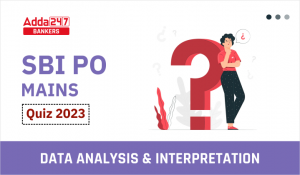Banking Awareness for NABARD Assistant Manager 2018
Q1. Which of the following rates is decided by the market conditions and not by RBI?
(a) Bank rate
(b) SLR
(c) CRR
(d) Inflation rate
(e) MSF
Q2. Proposals for setting up of new banks are under active consideration. Which organization gives this permission?
(a) RBI
(b) Indian Banks Association
(c) Finance Ministry
(d) Cabinet Committee on Economic Affairs
(e) SEBI
Q3. Basel norms are important international regulatory stipulations. It is meant for which sector?
(a) Insurance
(b) Banking
(c) Micro Finance
(d) Pension funds
(e) Trade
Q4. Which of the following institutions is not directly associated with the financial sector in India?
(a) Bombay Stock Exchange
(b) BIFR
(c) SEBI
(d) Planning Commission
(e) IBBI
Q5. Which discussing investments there is mention of short term government security. What is this type of investment known as?
(a) Debenture
(b) Mutual fund
(c) Treasury bill
(d) Share
(e) None of the given options is true
Q6. A bank normally does not have to deal with an issue related to—
(a) Payments and settlements system
(b) Contractual rights of creditors
(c) Intellectual property rights
(d) Cases of insolvency
(e) Education or Home loan
Q7. The monetary and credit policy of India is the responsibility of which of the following?
(a) Planning Commission
(b) Finance Ministry
(c) RBI
(d) National Advisory Council
(e) SEBI
Q8. When RBI raises the Cash Reserve Ratio rate what action are the banks required to take?
(a) They have to deposit additional money with RBI as reserve money
(b) Banks are required to increase their lending to the priority sector
(c) Banks also increase their lending and deposit rates
(d) All of the above
(e) None of the given options is true
Q9. Which of the following statements is correct?
(a) RBI is just like any ordinary commercial bank
(b) RBI is responsible for the overall monetary policy
(c) The fiscal policy of India is approved by RBI
(d) RBI has Dy. Chairman Planning Commission on its board
(e) None of the given options is true
Q10. Bank rate as fixed by RBI means—
(a) Rate of interest charged by banks from borrowers
(b) Rate of interest on bank deposits
(c) Rate of interest charged by RBI on its loans to banks
(d) Rate of interest on inter bank loans
(e) None of the given options is true
Q11. Increase in remittances from non resident Indians suggest—
(a) Increase in the balance of payments deficit in India
(b) Reduces the balance of payments deficit in India
(c) Has no effect on the balance of payments position
(d) All of the above
(e) None of the given options is true
Q12. Which of the following is not a method of credit control?
(a) Cash reserve ratio
(b) Open market operations
(c) Credit deposit ratio
(d) Bank rate policy
(e) None of the given options is true
Q13. The interest rate at which the RBI lends to commercial banks in the short term to maintain liquidity is known as—
(a) Interest rate
(b) Repo rate
(c) Reverse repo rate
(d) Bank rate
(e) Reverse Repo rate
Q14. What are the cooperative banks at the village level known as?
(a) Central cooperative banks
(b) Primary agricultural cooperative societies
(c) Village cooperative banks
(d) State cooperative banks
(e) None of the given options is true
Q15. Which nationalized bank was the first to sponsor a regional rural bank in India?
(a) Syndicate Bank
(b) Bank of India
(c) Union Bank of India
(d) Central Bank of India
(e) None of the given options is true






 Quantitative Aptitude Quiz For SBI PO Ma...
Quantitative Aptitude Quiz For SBI PO Ma...
 Inequalities Basic Reasoning Quiz for Al...
Inequalities Basic Reasoning Quiz for Al...




